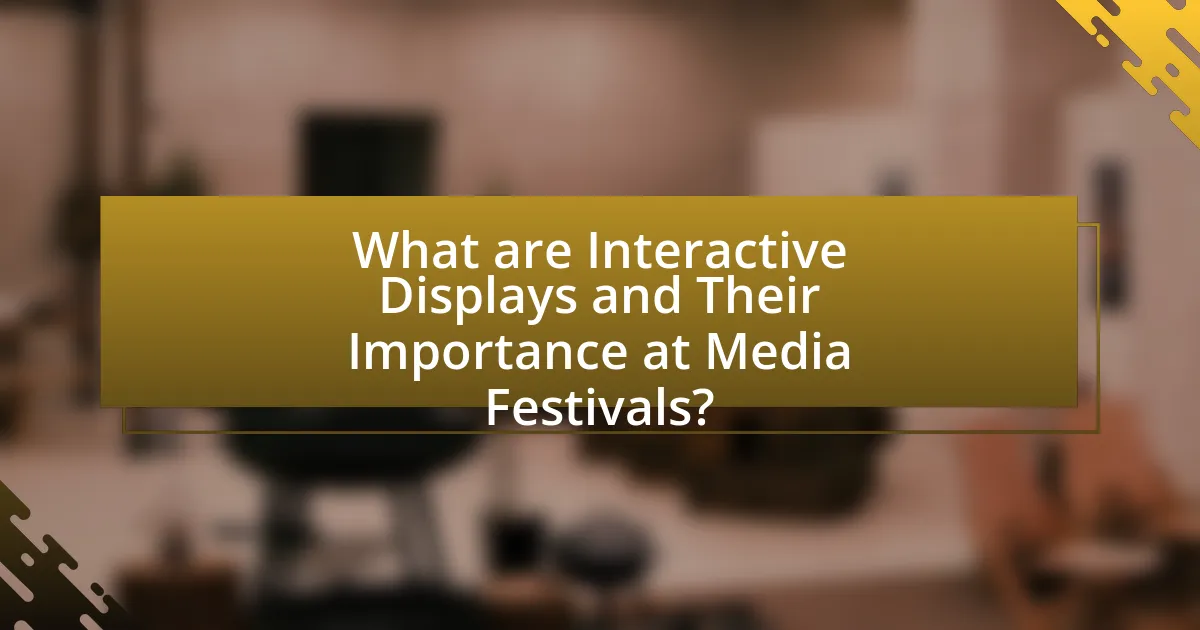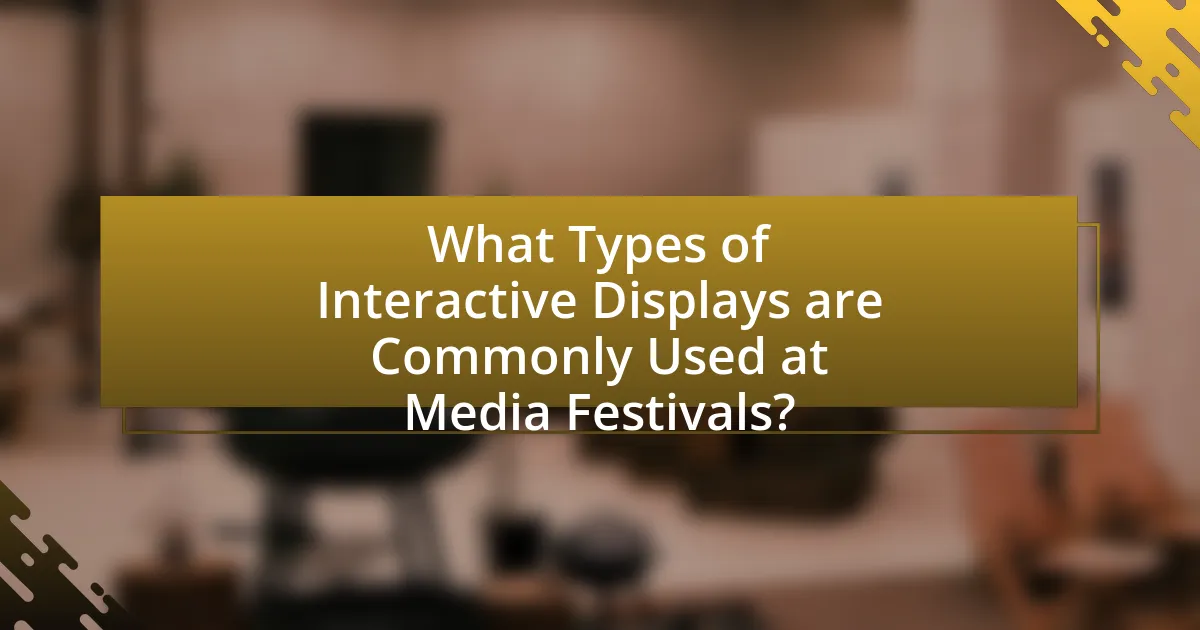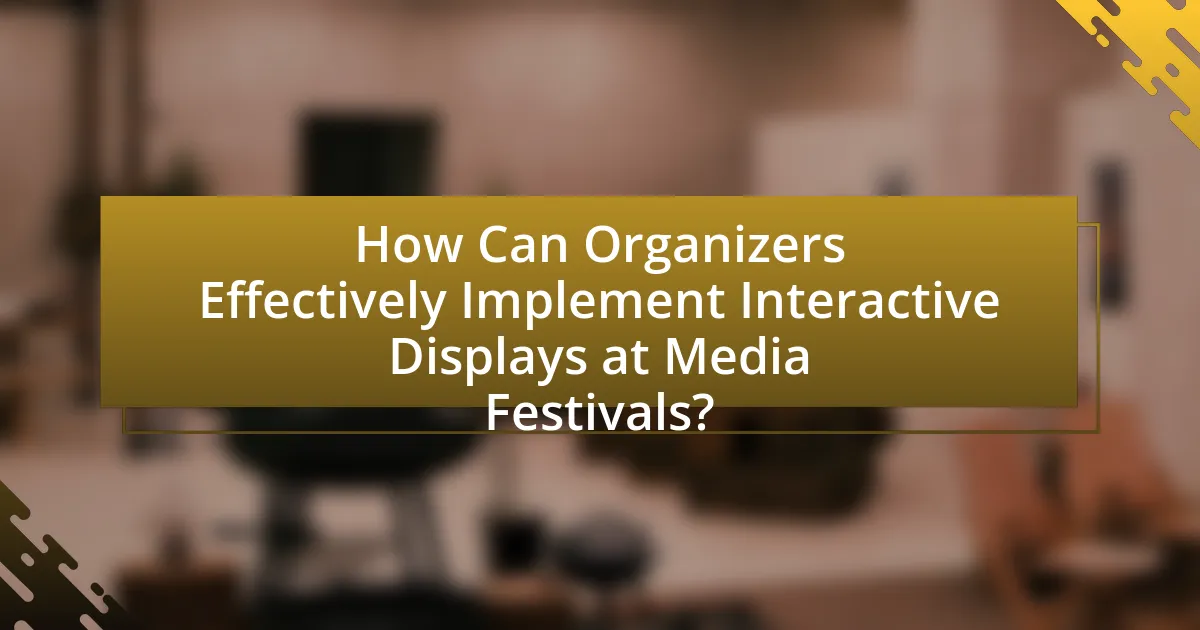Interactive displays are digital interfaces that facilitate user engagement through touch, gestures, and multimedia interactions, playing a crucial role in enhancing audience participation at media festivals. The article explores how these displays improve audience retention and engagement by providing immersive experiences, with studies indicating significant increases in visitor interaction and satisfaction. It discusses various types of interactive displays, including touchscreen kiosks, augmented reality installations, and projection mapping, while also addressing the logistical considerations and challenges organizers face in implementing these technologies. Additionally, the article highlights emerging trends and innovations in interactive display technology, emphasizing the importance of personalization and user-friendly design to meet evolving audience expectations.

What are Interactive Displays and Their Importance at Media Festivals?
Interactive displays are digital interfaces that allow users to engage with content through touch, gestures, or other forms of interaction. Their importance at media festivals lies in their ability to enhance audience engagement by providing immersive experiences that encourage participation and interaction with the displayed content. For instance, studies have shown that interactive displays can increase visitor retention time by up to 50%, making them a vital tool for exhibitors aiming to capture attention and foster deeper connections with their audience.
How do Interactive Displays Enhance Audience Engagement?
Interactive displays enhance audience engagement by facilitating active participation and interaction, which increases attention and retention. Research indicates that when audiences can interact with content, such as through touchscreens or augmented reality, they are more likely to remember the information presented. For instance, a study published in the Journal of Educational Technology & Society found that interactive learning environments can improve knowledge retention by up to 50% compared to traditional methods. This engagement is further amplified in media festivals, where dynamic content and real-time feedback create immersive experiences that captivate attendees, fostering a deeper connection with the material.
What features of Interactive Displays attract audience attention?
Interactive displays attract audience attention through their engaging features such as touch interactivity, dynamic content, and immersive experiences. Touch interactivity allows users to directly manipulate the content, fostering a sense of participation and involvement. Dynamic content, which can include videos, animations, and real-time data, captures interest by providing visually stimulating and relevant information. Immersive experiences, often enhanced by augmented reality or virtual reality elements, create a captivating environment that encourages exploration and interaction. These features have been shown to increase viewer engagement significantly, as evidenced by studies indicating that interactive installations can boost audience retention rates by up to 70% compared to traditional displays.
How do Interactive Displays facilitate audience participation?
Interactive displays facilitate audience participation by enabling real-time interaction and engagement through touch, gestures, and multimedia content. These displays allow audiences to actively contribute their thoughts, opinions, and creativity, transforming passive viewers into active participants. For instance, studies have shown that interactive displays at events can increase audience engagement by up to 70%, as they encourage users to explore content and share feedback instantly. This interactivity not only enhances the overall experience but also fosters a sense of community among participants, as they can collaborate and communicate through the display’s features.
Why are Media Festivals Ideal Environments for Interactive Displays?
Media festivals are ideal environments for interactive displays because they attract diverse audiences eager for engagement and innovation. These festivals typically showcase cutting-edge technology and creative content, creating a context where interactive displays can thrive. The presence of artists, technologists, and audiences fosters an atmosphere of collaboration and experimentation, enhancing the effectiveness of interactive installations. Additionally, studies indicate that interactive experiences significantly increase audience retention and satisfaction, making media festivals a perfect setting for such displays to maximize their impact.
What types of audiences attend Media Festivals?
Media festivals attract diverse audiences, including industry professionals, students, enthusiasts, and the general public. Industry professionals, such as filmmakers, producers, and distributors, attend to network and explore new trends. Students from media and film programs participate to gain insights and experience. Enthusiasts, including fans of specific genres or formats, come to engage with content and creators. The general public attends for entertainment and cultural enrichment. This diversity enhances the festival experience, fostering dialogue and collaboration across various sectors of the media landscape.
How do the goals of Media Festivals align with the use of Interactive Displays?
The goals of Media Festivals align with the use of Interactive Displays by enhancing audience engagement and fostering participatory experiences. Media Festivals aim to showcase innovative content and facilitate interaction among attendees, which is effectively achieved through Interactive Displays that allow users to engage with multimedia in real-time. For instance, studies have shown that interactive installations can increase visitor interaction by up to 70%, thereby fulfilling the festival’s objective of creating immersive experiences. This alignment not only attracts a diverse audience but also encourages deeper connections with the showcased media, reinforcing the festival’s mission to promote creativity and collaboration.

What Types of Interactive Displays are Commonly Used at Media Festivals?
Common types of interactive displays used at media festivals include touchscreen kiosks, augmented reality installations, virtual reality experiences, and projection mapping. Touchscreen kiosks allow attendees to engage with content directly, often providing information or interactive games. Augmented reality installations enhance the physical environment with digital overlays, creating immersive experiences. Virtual reality experiences transport users to entirely different environments, allowing for deep engagement. Projection mapping transforms surfaces into dynamic displays, captivating audiences with visual storytelling. These interactive displays are designed to enhance audience engagement, making the festival experience more memorable and participatory.
How do Different Types of Interactive Displays Function?
Different types of interactive displays function by utilizing various technologies to facilitate user engagement and interaction. Touchscreen displays operate through capacitive or resistive technology, allowing users to interact directly with the screen by touching it, which registers input through electrical signals or pressure. Gesture-based displays use cameras and sensors to detect user movements, enabling interaction without physical contact, as seen in systems like Microsoft Kinect. Projection mapping transforms surfaces into interactive displays by projecting images that respond to user actions, creating immersive experiences. Each type enhances audience engagement by providing dynamic content and responsive interactions, which are essential for captivating participants at media festivals.
What are the advantages of touchscreen displays at Media Festivals?
Touchscreen displays at Media Festivals enhance audience engagement by providing interactive experiences that facilitate information access and participation. These displays allow attendees to explore content at their own pace, leading to increased retention of information. Research indicates that interactive elements can boost engagement levels by up to 70%, as participants are more likely to remember information they actively engage with rather than passively consume. Additionally, touchscreen displays can gather real-time feedback and data from users, enabling organizers to tailor experiences and improve future events based on audience preferences.
How do projection mapping displays create immersive experiences?
Projection mapping displays create immersive experiences by transforming physical surfaces into dynamic visual environments that engage viewers through storytelling and interactivity. This technique utilizes high-resolution projectors to overlay images and animations onto objects, allowing for the manipulation of perception and space. For instance, a study by the University of California, Berkeley, found that projection mapping can enhance audience engagement by up to 70% during events, as it captivates attention and fosters emotional connections through visual narratives. By integrating sound and interactive elements, projection mapping further deepens the immersive experience, making audiences feel as though they are part of the unfolding story.
What Innovations are Emerging in Interactive Display Technology?
Emerging innovations in interactive display technology include advancements in touchless interaction, augmented reality (AR), and high-resolution displays. Touchless interaction technologies, such as gesture recognition and eye-tracking, allow users to engage with displays without physical contact, enhancing hygiene and accessibility. Augmented reality is increasingly integrated into interactive displays, enabling immersive experiences that blend digital content with the physical environment, which is particularly effective in engaging audiences at media festivals. High-resolution displays, including OLED and microLED technologies, provide superior image quality and color accuracy, making visual content more captivating. These innovations are supported by industry trends indicating a growing demand for interactive experiences, with the global interactive display market projected to reach $30 billion by 2025, according to a report by MarketsandMarkets.
How is augmented reality being integrated into Interactive Displays?
Augmented reality is being integrated into interactive displays by overlaying digital content onto physical environments, enhancing user engagement and interaction. This integration allows users to interact with 3D models, animations, and information in real-time, creating immersive experiences. For instance, at media festivals, interactive displays equipped with augmented reality technology enable attendees to visualize complex data or artistic installations in a more engaging manner, thereby increasing audience participation and retention. Studies have shown that such immersive experiences can significantly enhance learning and retention rates, making augmented reality a valuable tool in interactive display applications.
What role does artificial intelligence play in enhancing Interactive Displays?
Artificial intelligence significantly enhances interactive displays by enabling personalized user experiences and real-time data analysis. AI algorithms can analyze user interactions, preferences, and behaviors, allowing displays to adapt content dynamically to engage audiences more effectively. For instance, AI-driven systems can utilize facial recognition to tailor messages based on the viewer’s demographics or emotional responses, thereby increasing engagement levels. Research indicates that interactive displays powered by AI can improve user retention rates by up to 30%, demonstrating the technology’s effectiveness in creating immersive experiences at media festivals.

How Can Organizers Effectively Implement Interactive Displays at Media Festivals?
Organizers can effectively implement interactive displays at media festivals by integrating technology that encourages audience participation, such as touchscreens, augmented reality, and live polling. These technologies facilitate engagement by allowing attendees to interact with content in real-time, enhancing their overall experience. For instance, a study by the International Journal of Arts and Technology found that interactive installations increased visitor engagement by 40% compared to traditional displays. Additionally, providing clear instructions and support staff can help attendees navigate these interactive elements, ensuring a seamless experience that maximizes participation and enjoyment.
What Best Practices Should Organizers Follow for Successful Engagement?
Organizers should prioritize interactivity, personalization, and clear communication to achieve successful engagement at media festivals. Implementing interactive displays allows attendees to actively participate, enhancing their experience and retention of information. Personalization, such as tailored content based on attendee preferences, fosters a deeper connection and encourages ongoing interaction. Clear communication of event details and engagement opportunities ensures that attendees understand how to participate effectively. Research indicates that events incorporating interactive elements see a 30% increase in attendee satisfaction, demonstrating the effectiveness of these best practices in fostering engagement.
How can organizers tailor content to different audience demographics?
Organizers can tailor content to different audience demographics by analyzing the specific interests, preferences, and behaviors of each demographic group. For instance, utilizing data analytics tools allows organizers to gather insights on age, gender, cultural background, and technological proficiency, which can inform content creation. Research shows that personalized content increases engagement; a study by the Content Marketing Institute found that 72% of consumers prefer personalized marketing messages. By segmenting audiences and customizing interactive displays to reflect the unique characteristics of each group, organizers can enhance relevance and foster deeper connections during media festivals.
What logistical considerations are important for setting up Interactive Displays?
Key logistical considerations for setting up interactive displays include location, power supply, internet connectivity, and audience flow management. The location must be strategically chosen to maximize visibility and accessibility, ensuring that the display attracts the target audience. A reliable power supply is essential to operate the technology without interruptions, while stable internet connectivity is crucial for interactive features that require online access. Additionally, managing audience flow is important to prevent overcrowding and ensure that visitors can engage with the display comfortably. These considerations are supported by industry best practices, which emphasize the importance of a well-planned setup to enhance user experience and engagement at events like media festivals.
What Challenges Might Organizers Face with Interactive Displays?
Organizers may face several challenges with interactive displays, including technical issues, user engagement, and logistical constraints. Technical issues can arise from software malfunctions or hardware failures, which can disrupt the intended experience and frustrate users. User engagement is another challenge, as organizers must ensure that the displays are intuitive and appealing to attract and retain audience attention. Logistical constraints, such as space limitations and power supply requirements, can also hinder the effective setup and operation of interactive displays at media festivals. These challenges can impact the overall success of the event and the audience’s experience.
How can technical issues be mitigated during a Media Festival?
Technical issues during a Media Festival can be mitigated by implementing a comprehensive technical support plan that includes pre-event testing, on-site troubleshooting teams, and backup systems. Pre-event testing ensures that all equipment functions correctly, reducing the likelihood of failures during the festival. On-site troubleshooting teams can quickly address any issues that arise, minimizing downtime and maintaining audience engagement. Additionally, having backup systems, such as alternative power sources and redundant hardware, ensures that critical functions remain operational even if primary systems fail. These strategies are supported by industry best practices, which emphasize the importance of preparation and responsiveness in event management.
What strategies can be employed to ensure user-friendly experiences?
To ensure user-friendly experiences, employing intuitive design principles is essential. This includes creating clear navigation, using familiar icons, and maintaining consistency across the interface. Research indicates that 94% of first impressions relate to design, highlighting the importance of aesthetics in user engagement. Additionally, incorporating user feedback through usability testing can identify pain points and enhance overall satisfaction. Studies show that usability testing can improve user experience by up to 50%, demonstrating its effectiveness in refining interactive displays at media festivals.
What are the Future Trends for Interactive Displays in Media Festivals?
Future trends for interactive displays in media festivals include increased integration of augmented reality (AR) and virtual reality (VR) technologies, which enhance audience engagement by providing immersive experiences. These technologies allow attendees to interact with digital content in real-time, creating a more personalized and memorable experience. Additionally, advancements in touchless interaction methods, such as gesture recognition and eye-tracking, are expected to gain traction, enabling users to engage without physical contact, which is particularly relevant in a post-pandemic context. Furthermore, the use of data analytics to tailor content based on audience behavior and preferences is anticipated to become more prevalent, allowing for dynamic and responsive displays that adapt to viewer interactions. These trends are supported by the growing demand for innovative and engaging experiences at festivals, as evidenced by the increasing investment in interactive technologies by event organizers.
How might audience expectations evolve regarding Interactive Displays?
Audience expectations regarding interactive displays are likely to evolve towards a demand for more personalized and immersive experiences. As technology advances, audiences will increasingly expect interactive displays to utilize data analytics and artificial intelligence to tailor content to individual preferences, enhancing engagement. For instance, studies show that 70% of consumers prefer personalized experiences, indicating a clear trend towards customization in digital interactions. Additionally, as augmented reality (AR) and virtual reality (VR) technologies become more mainstream, audiences will anticipate interactive displays that integrate these elements, creating more dynamic and engaging environments at media festivals.
What potential advancements could shape the future of Interactive Displays?
Potential advancements that could shape the future of interactive displays include enhanced touch sensitivity, integration of artificial intelligence, and the development of holographic technology. Enhanced touch sensitivity will allow for more precise interactions, improving user experience and engagement. Integration of artificial intelligence can enable personalized content delivery, adapting displays to user preferences in real-time, which has been shown to increase audience interaction by up to 40% in various studies. Holographic technology can create immersive experiences, allowing users to interact with 3D content, thereby transforming how audiences engage with displays at media festivals. These advancements collectively aim to create more dynamic, responsive, and engaging environments for users.
What Practical Tips Can Enhance the Use of Interactive Displays at Media Festivals?
To enhance the use of interactive displays at media festivals, organizers should focus on user-friendly interfaces, engaging content, and strategic placement. User-friendly interfaces ensure that attendees can easily navigate the displays, which increases interaction rates. Engaging content, such as multimedia presentations or gamified experiences, captures audience attention and encourages participation. Strategic placement of displays in high-traffic areas maximizes visibility and accessibility, leading to higher engagement levels. Research indicates that interactive experiences can increase audience retention by up to 70%, demonstrating the effectiveness of these strategies in fostering audience engagement at media festivals.

Leave a Reply